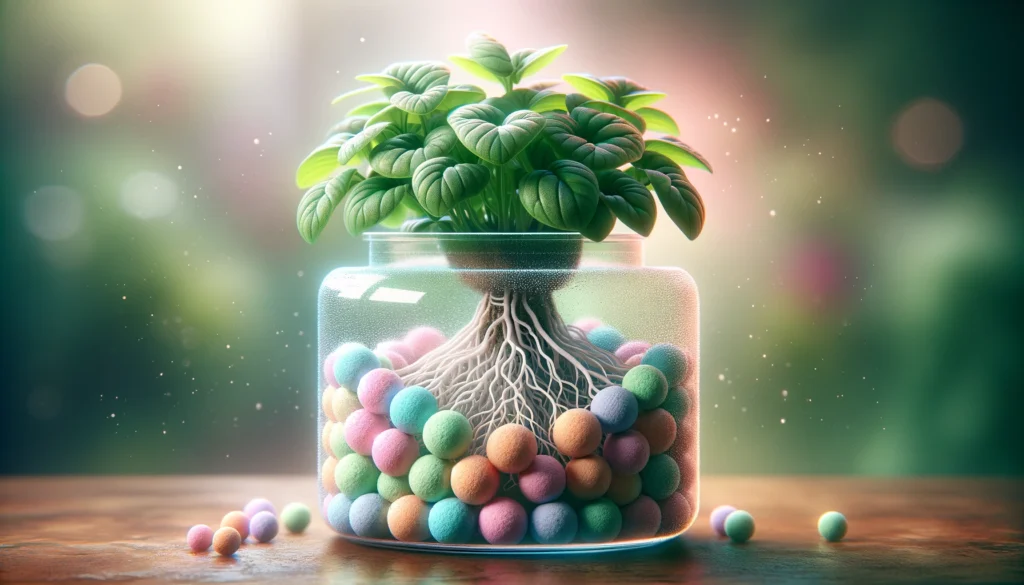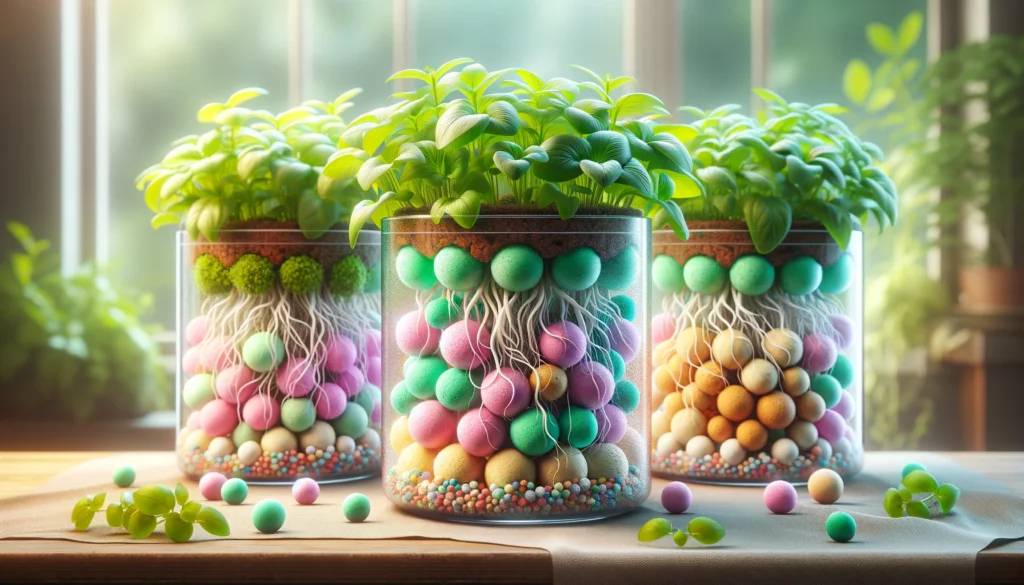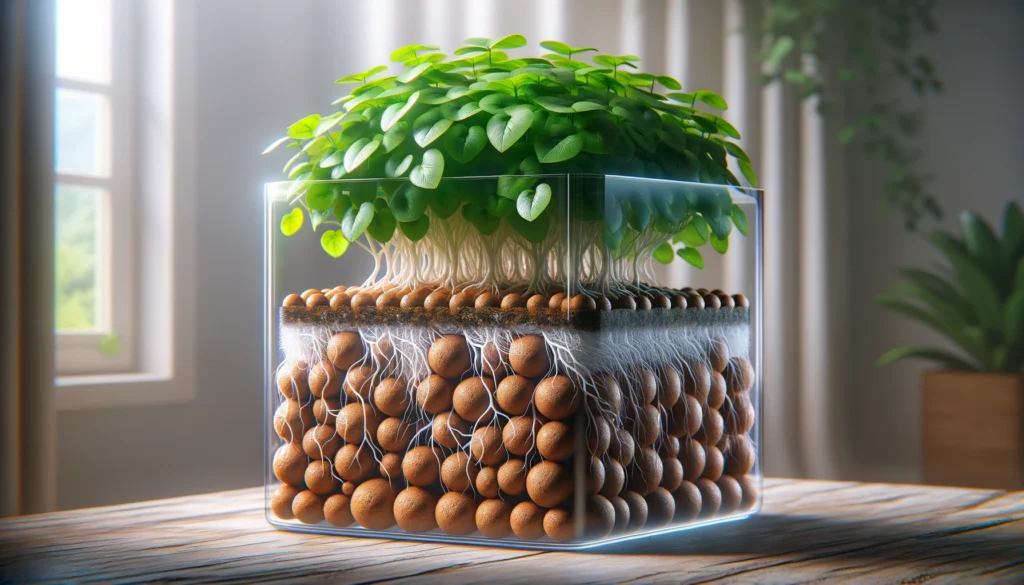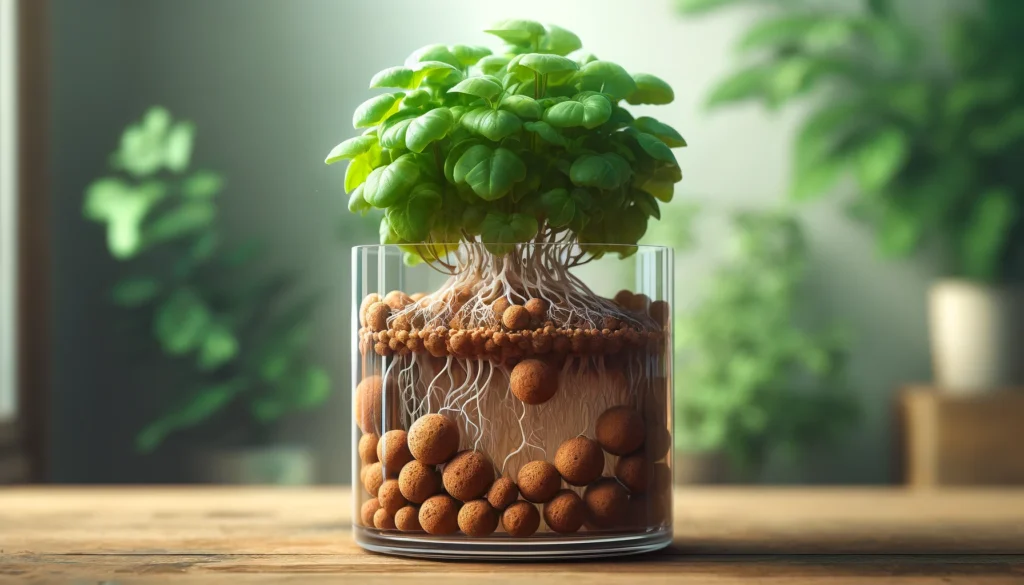Nurturing the seed of an idea to grow your own veggies doesn’t have to end in defeat—at least not when you’ve got the Kratky method up your sleeve. Picture this: you, sipping your morning coffee, watching those little green sprouts pushing up through a LECA-based hydroponic setup, plump and fresh and ready for the plucking. This ultimate guide is set to be your roadmap, leading you step by easy step through the process of setting up your own LECA-based hydroponic system. But it’s not all about the technicalities of LECA and hydroponics. We’ll also share stories from fellow green-thumbs who were once in your shoes and are now reeping the fruits, or rather greens, of their labor. So, are you ready to embark on a delightful journey of effortless gardening and sustainable living with us? Here’s how to get started.
Understanding Hydroponics and LECA
What are Hydroponics?
Ever thought about growing your own plants, but don’t have enough space or soil? Maybe you’ve heard about hydroponics? Hydroponics is an innovative method of gardening that doesn’t require soil, instead, plants are grown in an aquatic based environment. Imagine sipping your morning coffee while checking on your thriving herbs grown in water. Sounds peaceful, right?
Why choose Hydroponics over traditional gardening?
So, why would we choose hydroponics over traditional gardening? Well, hydroponics offer numerous advantages. Firstly, it eliminates the messy soil, and thanks to the controlled environment, there will also be fewer pests and diseases. Additionally, it leads to quicker growth and higher yields. Imagine getting those juicy cherry tomatoes faster than you would in a traditional garden!
What is LECA and why is it used in Hydroponics?
Now, you’re probably wondering about LECA. LECA stands for Lightweight Expanded Clay Aggregate. Sounds technical, doesn’t it? Well, it’s just small clay balls that have been heated up to pop like popcorn, making them lightweight and porous. In hydroponics, they are used to help anchor the plants and they are fantastic at absorbing water and nutrients, distributing them evenly to your plants’ roots.
Different types of Hydroponic systems
There are actually several types of hydroponic systems, each with its own benefits. These systems include Deep Water Culture, Nutrient Film Technique, Ebb and Flow, Aeroponics, and of course, our friend, the LECA system. Depending on your needs, space and what you’re growing, different systems might be more suitable.
The role of LECA in Hydroponic systems
LECA plays a crucial role in hydroponic systems. It not only replaces soil, providing a place for roots to anchor but also aids in nutrient uptake and aeration for the plants. Who knew these tiny clay balls could do so much?
Benefits of LECA Hydroponic System
Sustainability and Environmentally friendliness
We all want to do our part in helping the environment, right? That’s another reason to love LECA hydroponic systems. They use considerably less water than traditional soil-based plants, and due to LECA’s reusability, it reduces waste.
Ease of set up and maintenance
Here’s the best part – setting up a LECA hydroponic system is surprisingly simple. Even if you’re not a DIY master, we promise, you can do this! And maintaining it is even easier, with fewer pests and diseases, plus no soil to turn or weeds to pull.
Cost-effectiveness
Hydroponics might sound like an expensive endeavor, but it’s not when it comes to a LECA system. Once you’ve got it set up, the running costs are minimal.
Space benefits
Not everyone has a spacious garden, but the good news is that you don’t need a lot of space for a hydroponic system. You can set it up indoors, on a sunny windowsill, or even in a small apartment.
Faster plant growth
In a LECA hydroponic system, nutrients are more easily accessible to plants. Because of this, they can grow up to 50% faster than they would in soil. Imagine seeing those seedlings sprout before your eyes!

Deciding What to Grow
Suitable plants for a LECA Hydroponic system
Almost any type of plant can be grown in a LECA hydroponic system. This includes a huge variety of herbs and vegetables, houseplants, and even flowers. Ever fantasized about having fresh basil for your pizza or mint for your cocktail right at your fingertips?
Considerations when selecting plants
While many plants thrive in a LECA hydroponic system, it’s important to consider factors like the plant’s size, the amount of light it needs, and the temperature it prefers before deciding to grow it in your new system.
Tips on how to start seeds correctly
Starting seeds in hydroponics may seem confusing, but we’ve got your back. It’s important to keep them in a moist environment until they germinate. Handle them gently, give them enough light, and remember, patience is a virtue, even when your plants are growing faster!
Purchasing LECA
Where to buy LECA
You can find LECA in most gardening stores or even online. We live in an amazing time, don’t we? With just a few clicks, you can have everything you need delivered right to your doorstep.
Factors to consider when buying LECA
When buying LECA, look for quality. It should be evenly shaped, lightweight, and porous. It might seem simple, but quality LECA will make a difference to your plants’ health and growth.
Cost of LECA and budgeting
Although LECA is a little more expensive than regular potting mix, remember, it’s reusable. With proper care, LECA can last for years, making it a cost-effective choice in the long run.

Preparing the LECA
Steps to properly clean and prepare LECA
Before you get started, it’s important to properly clean and prepare your LECA. Soak it in water for at least an hour, rinse it, then soak it again in a nutrient solution. Sounds simple, right?
Do’s and Don’ts when preparing LECA
Do rinse your LECA thoroughly. Don’t skip the soaking process. Do let your LECA dry out between waterings. Don’t reuse LECA from a diseased plant without sterilizing it first.
Common mistakes in preparing LECA and how to avoid them
A common mistake when preparing LECA is not rinsing or soaking it properly. This can lead to poor plant growth. To avoid this, just remember: rinse, soak, plant, and you’re on your way to becoming a hydroponic pro!
Setting Up the Hydroponic System
Required materials and equipment
To set up your LECA hydroponic system, you will need a container, LECA, a hydroponic nutrient solution, pH test kit, and of course, your plants or seeds. None of these are hard to find or use – we promise!
Step by step process of setting up a LECA-based Hydroponic system
First, prepare your LECA and place your plant in the container. Fill it with LECA, making sure the roots are well covered. Add water until it just covers the bottom layer of LECA. Easy peasy, right?
Safety measures to consider when setting up
As with any project, safety is key. Be mindful of electrical connections if you’re using lights or air pumps. Remember to handle your nutrient solution with care and keep it out of reach of children and pets.

Maintaining Your LECA Hydroponic System
Watering and nutrient requirements
Hydroponics makes watering easy. You just top up the water when it gets low, and refresh the nutrient solution every couple of weeks. You’re probably thinking, “Hey, that sounds easier than traditional gardening!” And you’re right, it is!
How to check and maintain the pH levels
Checking and maintaining the pH level of your water is essential in a LECA hydroponic system. Just use the pH test kit to ensure your water is slightly acidic, between 5.5 and 6.5 is best. You can easily adjust the pH with solutions from your local gardening store.
Cleaning the system
Every once in a while, it’s a good idea to clean your system. This includes washing your LECA (remember, it’s reusable!), cleaning out your container, and mixing up a fresh batch of nutrient solution. This will help keep your plants healthy and happy.
Troubleshooting Common Problems
Identifying common plant diseases in hydroponic systems
Just like in any garden, plants in a hydroponic system can still get diseases. Not to worry, though. With early detection and correct diagnosis, most plant diseases can be easily treated.
How to control pests in your hydroponic system
The good news is, hydroponics generally have fewer pest problems. But if pests do find their way in, they can be managed with a variety of organic or chemical solutions.
Solutions for nutrient deficiencies
Are your plants looking weak or yellow? They might be lacking nutrients. But don’t worry, fixing nutrient deficiencies is usually as simple as adjusting your nutrient solution or, in some cases, changing it out more frequently.

Harvesting Your Plants
When to harvest different plants
Just like in traditional gardening, knowing when to harvest depends on the plant. Leafy greens can be harvested when they have enough leaves to sustain continued growth. For fruiting plants, size and color are the usual indicators.
How to harvest without damaging the plant
Harvest gently to avoid damaging the plant or the root system. For leafy greens, it’s often best to simply pick leaves from the plant, allowing it to continue growing. For fruiting plants, a sharp, clean instrument will result in the cleanest cut and least damage to your plant.
Post-harvest care for plants
After harvest, it’s important to check your plants for any signs of disease or pests. This is also a good time to check the roots and water level, and to replace the nutrient solution if needed.
Getting Involved in the Hydroponic Community
Where to find like-minded hydroponic enthusiasts
There is a thriving online community of hydroponic enthusiasts, where beginners are welcome. Social networks, forums, and gardening websites are a great place to exchange tips, share successes (and failures), and get advice from more experienced growers.
Learning resources for improving your hydroponic skills
Why not consider enrolling in a hydroponics course? There are also countless books, blogs, and articles available to deepen your understanding and skills.
How to contribute and learn from the hydroponic community
Don’t be shy, share your experiences and ask questions! The more you engage, the more you will learn. The hydroponics community is full of friendly enthusiasts (like us), who are always happy to help one another out.
Whew! We’ve covered a lot here – but that’s because we want to ensure you’re fully prepared to venture into the world of hydroponics. So, ready to get your hands wet and turn your thumb green with this easy hydroponic system? Join us in nurturing our plants and the planet, one clay ball at a time!
Related Products…
-
%27%20fill-opacity%3D%27.5%27%3E%3Cellipse%20fill%3D%22%23417060%22%20fill-opacity%3D%22.5%22%20rx%3D%221%22%20ry%3D%221%22%20transform%3D%22rotate(178.7%2045.4%2076.1)%20scale(68.0897%20104.44226)%22%2F%3E%3Cellipse%20fill%3D%22%23fff%22%20fill-opacity%3D%22.5%22%20rx%3D%221%22%20ry%3D%221%22%20transform%3D%22rotate(-44.1%20417.3%20-261.4)%20scale(166.00359%2079.83099)%22%2F%3E%3Cellipse%20fill%3D%22%23fcf3f6%22%20fill-opacity%3D%22.5%22%20rx%3D%221%22%20ry%3D%221%22%20transform%3D%22matrix(-.12668%20-18.4783%20298.8211%20-2.04865%20149.5%2014.4)%22%2F%3E%3Cellipse%20fill%3D%22%234bb691%22%20fill-opacity%3D%22.5%22%20rx%3D%221%22%20ry%3D%221%22%20transform%3D%22rotate(-89.2%2098.8%200)%20scale(51.03237%2075.94043)%22%2F%3E%3C%2Fg%3E%3C%2Fsvg%3E) Organic Colorful Leca Balls 2LBS – Natural Ceramsite Clay Pebbles 8mm-10mm for Indoor Plant Growth, Orchids, Succulents, Hydroponics, and Drainage (2LBS)$13.99
Organic Colorful Leca Balls 2LBS – Natural Ceramsite Clay Pebbles 8mm-10mm for Indoor Plant Growth, Orchids, Succulents, Hydroponics, and Drainage (2LBS)$13.99 -
%27%20fill-opacity%3D%27.5%27%3E%3Cellipse%20fill%3D%22%23333a43%22%20fill-opacity%3D%22.5%22%20rx%3D%221%22%20ry%3D%221%22%20transform%3D%22matrix(97.98278%2016.3967%20-14.36296%2085.82966%20136%20299.6)%22%2F%3E%3Cellipse%20fill%3D%22%23f9ffff%22%20fill-opacity%3D%22.5%22%20rx%3D%221%22%20ry%3D%221%22%20transform%3D%22matrix(-25.34727%20-67.07962%2058.17666%20-21.98313%20.5%20177)%22%2F%3E%3Cellipse%20fill%3D%22%23ffcbd9%22%20fill-opacity%3D%22.5%22%20rx%3D%221%22%20ry%3D%221%22%20transform%3D%22matrix(60.42973%20-131.36355%2047.02909%2021.63428%20188.2%2060.6)%22%2F%3E%3Cellipse%20fill%3D%22%2387a528%22%20fill-opacity%3D%22.5%22%20rx%3D%221%22%20ry%3D%221%22%20transform%3D%22matrix(-3.74185%20-41.11602%2065.67162%20-5.97659%2080%2074)%22%2F%3E%3C%2Fg%3E%3C%2Fsvg%3E) 10 Pounds of Organic Clay Pebbles 4mm-16mm Leca for Plants – 100% Natural Hydroton Clay Pebbles for Hydroponic Gardening, Orchids, Drainage, Decor, and Aquaponics$21.99
10 Pounds of Organic Clay Pebbles 4mm-16mm Leca for Plants – 100% Natural Hydroton Clay Pebbles for Hydroponic Gardening, Orchids, Drainage, Decor, and Aquaponics$21.99 -
%27%20fill-opacity%3D%27.5%27%3E%3Cellipse%20fill%3D%22%23f9ffff%22%20fill-opacity%3D%22.5%22%20rx%3D%221%22%20ry%3D%221%22%20transform%3D%22rotate(-93.9%20110.4%20117.6)%20scale(183.30226%2052.00452)%22%2F%3E%3Cpath%20fill%3D%22%23edffff%22%20fill-opacity%3D%22.5%22%20d%3D%22M217%20342l63.7-255.8L382%20111.5l-63.8%20255.8z%22%2F%3E%3Cellipse%20fill%3D%22%23925a29%22%20fill-opacity%3D%22.5%22%20rx%3D%221%22%20ry%3D%221%22%20transform%3D%22matrix(-2.2522%20258.0776%20-99.68608%20-.86995%20150.8%2060.5)%22%2F%3E%3Cellipse%20fill%3D%22%23467773%22%20fill-opacity%3D%22.5%22%20rx%3D%221%22%20ry%3D%221%22%20transform%3D%22matrix(-1.44192%2034.30512%20-92.91304%20-3.90535%20164%20210.7)%22%2F%3E%3C%2Fg%3E%3C%2Fsvg%3E) 4.4 Pounds of Multicolored Garden LECA Clay Pebbles – Premium Quality for Hydroponics, Aquaponics, and Soil$12.99
4.4 Pounds of Multicolored Garden LECA Clay Pebbles – Premium Quality for Hydroponics, Aquaponics, and Soil$12.99
Forum
Got something to share or a question to ask? Jump in and start a conversation! Whether it’s tips, advice, or just sharing your experiences, we’d love to hear from you. Don’t be shy—your input could inspire or help someone else!- This forum has 1 topic, and was last updated 9 months ago by .
- Topic
- Voices
- Last Post
- You must be logged in to create new topics.





